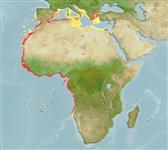Elasmobranchii (sharks and rays) >
Squatiniformes (Angel sharks) >
Squatinidae (Angel sharks)
Etymology: Squatina: Latin for skate, which angel sharks superficially resemble, presumably tautonymous with Squalus squatina Linnaeus 1758 (no species mentioned) (See ETYFish); aculeata: Latin for sharp-pointed, referring to large thorns on head and along back (See ETYFish).
More on author: Cuvier.
Environment: milieu / climate zone / depth range / distribution range
Ecology
Marine; demersal; depth range 30 - 500 m (Ref. 247). Subtropical; 43°N - 19°S, 18°W - 30°E
Eastern Atlantic: western Mediterranean, Morocco, Senegal, Guinea to Nigeria, Gabon to Angola.
Length at first maturity / Size / Weight / Age
Maturity: Lm ?, range 124 - ? cm
Max length : 188 cm TL male/unsexed; (Ref. 247); common length : 100.0 cm TL male/unsexed; (Ref. 26999); max. published weight: 40.0 kg (Ref. 128028)
Found mainly on muddy bottom (Ref. 26999). Feeds on small sharks and jacks. Ovoviviparous (Ref. 50449). Utilized dried salted and fresh for human consumption; liver oil and hide also utilized (Ref. 247).
Life cycle and mating behavior
Maturity | Reproduction | Spawning | Eggs | Fecundity | Larvae
Ovoviviparous, embryos feed solely on yolk (Ref. 50449).
Compagno, L.J.V., 1984. FAO Species Catalogue. Vol. 4. Sharks of the world. An annotated and illustrated catalogue of shark species known to date. Part 1 - Hexanchiformes to Lamniformes. FAO Fish. Synop. 125(4/1):1-249. Rome, FAO. (Ref. 247)
IUCN Red List Status (Ref. 130435: Version 2024-1)
Threat to humans
Harmless
Human uses
Fisheries: minor commercial
Tools
Special reports
Download XML
Internet sources
Estimates based on models
Preferred temperature (Ref.
123201): 13.1 - 17.2, mean 15.2 °C (based on 65 cells).
Phylogenetic diversity index (Ref.
82804): PD
50 = 0.5000 [Uniqueness, from 0.5 = low to 2.0 = high].
Bayesian length-weight: a=0.00676 (0.00295 - 0.01551), b=3.07 (2.88 - 3.26), in cm total length, based on LWR estimates for this Genus-body shape (Ref.
93245).
Trophic level (Ref.
69278): 4.0 ±0.4 se; based on diet studies.
Resilience (Ref.
120179): Low, minimum population doubling time 4.5 - 14 years (Fec assumed to be <100).
Fishing Vulnerability (Ref.
59153): Very high vulnerability (90 of 100).
Nutrients (Ref.
124155): Calcium = 13.9 [3.0, 67.9] mg/100g; Iron = 0.738 [0.191, 2.174] mg/100g; Protein = 19.7 [17.7, 21.7] %; Omega3 = 0.371 [0.168, 0.804] g/100g; Selenium = 33.5 [9.7, 99.1] μg/100g; VitaminA = 9.1 [3.3, 26.2] μg/100g; Zinc = 0.41 [0.20, 0.74] mg/100g (wet weight);
